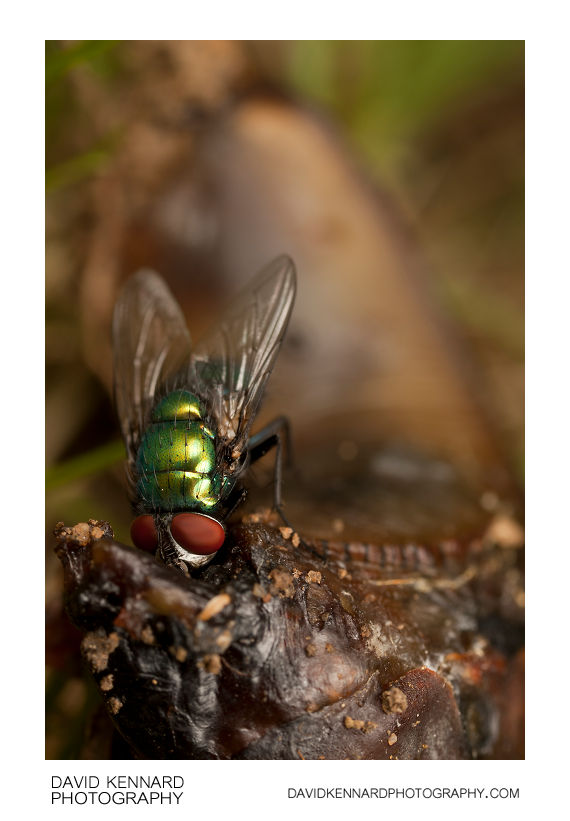Green-bottle fly (Lucilia sp.)

Description
- Title:
- Green-bottle fly (Lucilia sp.)
- Caption / Description:
-
A Lucilia species green-bottle fly feeds on a dead slug. There are 35 species of green-bottle found in the UK, and generally identification to the species level is only possible under a microscope.
From Wikipedia (http://en.wikipedia.org/wiki/Green_bottle_fly):
The name green bottle fly (or greenbottle fly) is applied to numerous species of blowfly, in the genera Lucilia and Phaenicia (the latter is sometimes considered a subgenus of the former). These flies are found in most areas of the world, and the most well-known species is the common greenbottle, Phaenicia sericata (or Lucilia sericata, depending on authority), though there are other common species such as Lucilia caesar, Lucilia cuprina, Lucilia coeruleiviridis, and Lucilia illustris.
The maggots of this fly are known to preferentially consume dead tissue while leaving live tissue intact, and so have been sold for use in maggot therapy, primarily during the years before the widespread use of antibiotics and medicines and in modern times due to a resurgence of medical literature documenting their effectiveness. These flies are known to lay eggs in cadaver tissue in the wild within hours after death. The developmental stage of their larvae in the cadaver can be used to accurately predict the time death occurred.
- Tags / Keywords:
-
- Biota
- Life
- Vitae
- Eukaryota
- Animalia
- Animals
- Arthropoda
- Arthropods
- Insecta
- Insects
- Diptera
- Flies
- Calliphoridae
- Blow flies
- Lucilia
- Greenbottle
- Green bottle
- Feeding
Admin
- Date Original Photo Taken:
- Original File Name:
- _MG_1796.CR2
- Event:
- Rating:
- ☆
- Date this image added/last updated on website:
- Original File Dimensions:
- 2848px x 4272px
- File Type:
- JPEG
- Color Mode:
- RGB
- Original Image Color Profile:
- Adobe RGB (1998)
Location
- Location Created:
-
- Sublocation:
- City:
- Market Harborough
- Province/State:
- Leicestershire
- Country:
- United Kingdom
- World Region:
- Europe
- Geo-location:
Rights
- Copyright Status:
- Copyrighted
- Licensing Status:
- Rights Managed
- Available for Editorial Use:
- Yes
- Available for Commercial Use:
- Yes
- Copyright Notice:
- © 2010 Dave Kennard
Camera Data
- Date Digital Resource was created:
- Shutter speed:
- 1⁄200 s
- Aperture:
- f/8
- Camera Model:
- Canon EOS 450D
- ISO:
- 100
- Exposure Compensation:
- 0
- Focal Length:
- 65mm
- Focal Length (35mm equiv.):
- Metering Mode:
- Multi-segment
- Flash:
- On, Fired
- Exposure Mode:
- Manual
- White Balance:
- Manual
- Light Source:
- Exposure Program:
- Manual
Additional shooting metadata
- Lens:
- Canon MP-E 65mm F2.8 1-5x Macro
- Filters used:
- Additional Optics used:
- Setup:
- Handheld
Canon MT-24EX Macro Twin Flash with home-made Concave diffusers
Post Processing
- Image Modified:
- Software used:
-
- Adobe Camera RAW
- Post Processing:
11 recovery in ACR
